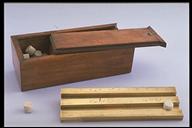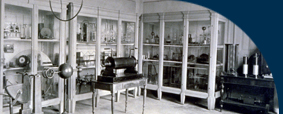|
OUR COLLECTION OF SCIENTIFIC INSTRUMENTS
HEAT |

 |
Wedgwood's pyrometer |
 |
Pirometro di Wedgwood |
| Subjects: heat/ high temperature reader (ovens) |
Settore: calore/misuratore di alte temperature (forni) |
| Inventory Number: 346 |
Numero di inventario: 346 |
| Unsigned |
Non firmato |
| 2/2 of the 19th century |
Periodo di costruzione: 2/2 del XIX secolo |
| Brass, mahogany, clay |
Materiale utilizzato: Ottone, mogano, argilla |
| 182 X 74 X 55 [mm] |
Dimensioni: 182 x 74 x 55 [mm] |
| |
|
This instrument, the description of which is still to be found in manuals of the late nineteenth century, is used to measure very high temperatures, even though it is not extremely precise. It was projected and built between 1782 and 1786 by the famous English potter Josiah Wedgwood (1730-1795) and its first scientific application was in the production of ceramics. Wedgwood was a member of the Royal Society and of the Lunar Society of Birmingham, which was comprised of the most famous chemists of that time. He produced of ornamental crockery (Etruria) and, in a period during which the industrial revolution favoured interaction between technological procedures and scientific research, he organized his activity frequenting scientists, and committing himself to experimental research on the working of clay, glazing, colouring and the control of high temperatures. Concerning this last question, the use of kilns in the working of clay required the development of appropriate pyrometers. Wedgwood presented his pyrometer in 1786 to King George III of England, publishing three articles on the subject. |
Questo strumento, la cui descrizione è ancora presente nei manuali del tardo ottocento, sebbene non molto esatto, permette di misurare con grande facilità temperature molto elevate. Fu progettato e costruito tra il 1782 e il 1786 dal famoso vasaio inglese Josiah Wedgwood (1730-1795) e nacque come applicazione scientifica alla manifattura della ceramica. Socio della Royal Society e della Lunar Society di Birmingham (che annoverava i più noti chimici inglesi del tempo), Wedgwood, che aveva una sua industria di vasellame ornamentale (Etruria), in un periodo in cui la rivoluzione industriale favoriva lo sviluppo di processi interattivi tra procedimenti tecnologici e ricerca scientifica, organizzò la sua attività circondandosi di uomini di scienza, prodigandosi in ricerche sperimentali sulla lavorazione della creta, sui processi di smaltatura, di colorazione e sul controllo delle alte temperature. Su quest'ultimo problema, l'utilizzo degli altiforni nella lavorazione dei materiali argillosi imponeva l'ideazione di appropriati pirometri. Wedgwood presentò il suo pirometro nel 1786 al Re Giorgio III d'Inghilterra, pubblicando a riguardo tre articoli nelle «Philosophical transactions» della Società Reale di Londra. |
| |
|
Description: The rectangular mahogany box, with a sliding lid, is divided into two parts; one of them contains 18 cylindrical pieces of dried white clay. On the box is a ruler fitted with a joint; it is a rectangular brass plate in which there are two conical grooves. These are shaped in such a way that if they were placed one after the other, the second would look like an extension of the first. The thermometric scale, which is engraved on both external sides of the two grooves, has a scale divided into single degrees from 0° to 230°. A double carving on the surface that divides the two grooves indicates that the zero of the pyrometer corresponds to 500°C and that any single degree of the instrument corresponds to an increase in temperature of 72°C. The instrument is based on the clay’s property of losing its volume due to the loss of crystallized water if it is placed in high temperature environments and also for its contraction during cooling. According to Wedgwood, the decrease in volume of the the pieces of dried white clay was proportional to the increase in temperature. |
Descrizione: La scatola rettangolare in mogano, con coperchio a scorrimento, è divisa in due scomparti; in uno di essi sono riposti 18 tronchetti cilindrici di argilla essiccata bianca. Sopra gli scomparti, appoggiato ad incastro, vi è riposto il regolo, una piastra rettangolare, interamente d'ottone, in cui sono praticate due scanalature coniche. Queste sono lavorate in modo tale che se si mettessero l'una di seguito all'altra, la seconda formerebbe il prolungamento della prima. La scala termometrica, incisa su ambo i lati esterni delle due scanalature, reca una tacchettatura con la divisione in singoli gradi che si estende da 0 a 230º. Una doppia incisione sulla superficie del pianerottolo che divide le due scanalature ricorda che lo zero del pirometro corrisponde a 500 ºC e che ogni grado dello strumento corrisponde ad un aumento di temperatura di 72 gradi centigradi. Lo strumento si basa sulla proprietà che ha l'argilla di diminuire il proprio volume per la perdita dell'acqua di cristallizzazione se posta in ambienti ad alta temperatura e per l'aggiuntiva contrazione durante il raffreddamento. Secondo il Wedgwood, tali diminuzioni di volume erano sensibilmente proporzionali agli aumenti di temperatura. |
| |
|
Function: the measurement of temperature is carried out by placing the small clay cylinder into the conical groove of the pyrometer, by observing the mark it reaches and, subsequently, by placing it in the environment the temperature of which is to be measured. Later the small cylinder is removed from the environment so that it may cool. When the small cylinder reaches the ordinary temperature it is once again inserted into the groove of the ruler so that it can slide along it until it stops. The new position represents the second graduation of the ruler which, subtracted from the first one, then multiplied by seventy-two and added to 500, shows the temperature increase of clay, expressed into degrees.
|
Funzionamento: la misura della temperatura avviene, dapprima, ponendo il cilindretto d'argilla nel canale conico del pirometro, osservando così a quale divisione lungo il ristringimento esso giunge e quindi ponendolo nell'ambiente di cui si vuol determinare la temperatura. Successivamente si estrae il cilindretto dall'ambiente e lo si lascia raffreddare. Raggiunta la temperatura ordinaria, il cilindretto viene di nuovo fatto scorrere nella scanalatura del regolo fino al suo arresto. La nuova posizione fornisce la lettura della seconda divisione della graduazione del regolo, la quale, sottratta alla prima e moltiplicata per settantadue, fornisce approssimativamente, con l'aggiunta di 500, l'aumento di temperatura in gradi subita dall'argilla. |
| |
|
Bibliography: Wedgwood [1782, 1784, 1786], pp. 305-326; 358-384; 390-408; Salleron [1864], p. 214; Musson, Robinson [1969], p. 78. |
Bibliografia: Wedgwood [1782, 1784, 1786], pp. 305-326; 358-384; 390-408; Salleron [1864], p. 214; Musson, Robinson [1969], p. 78 |
|
|
|

